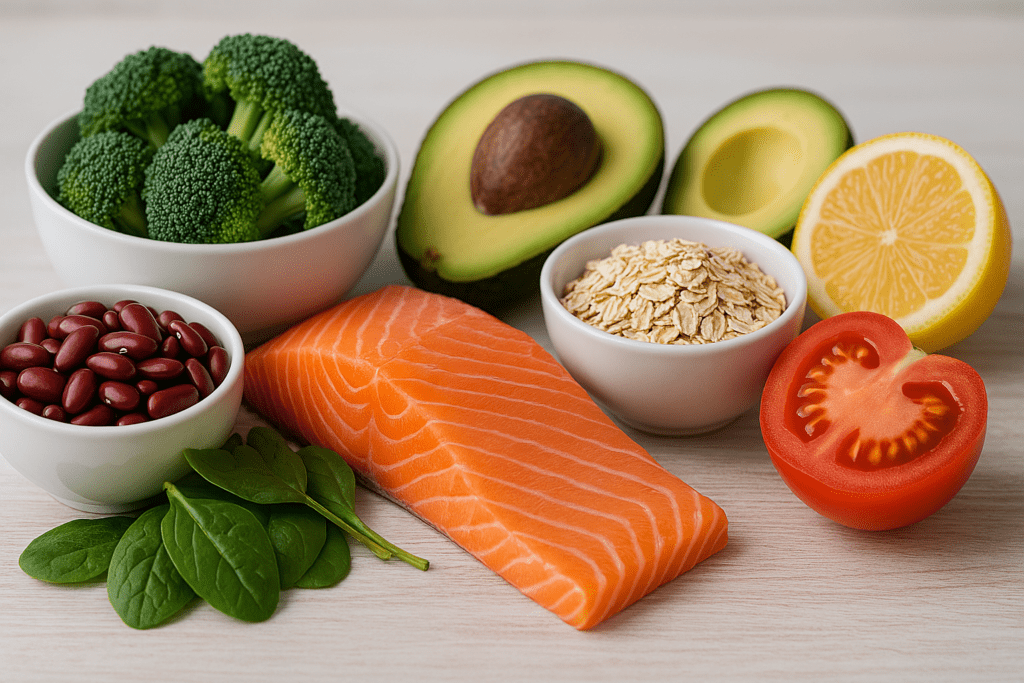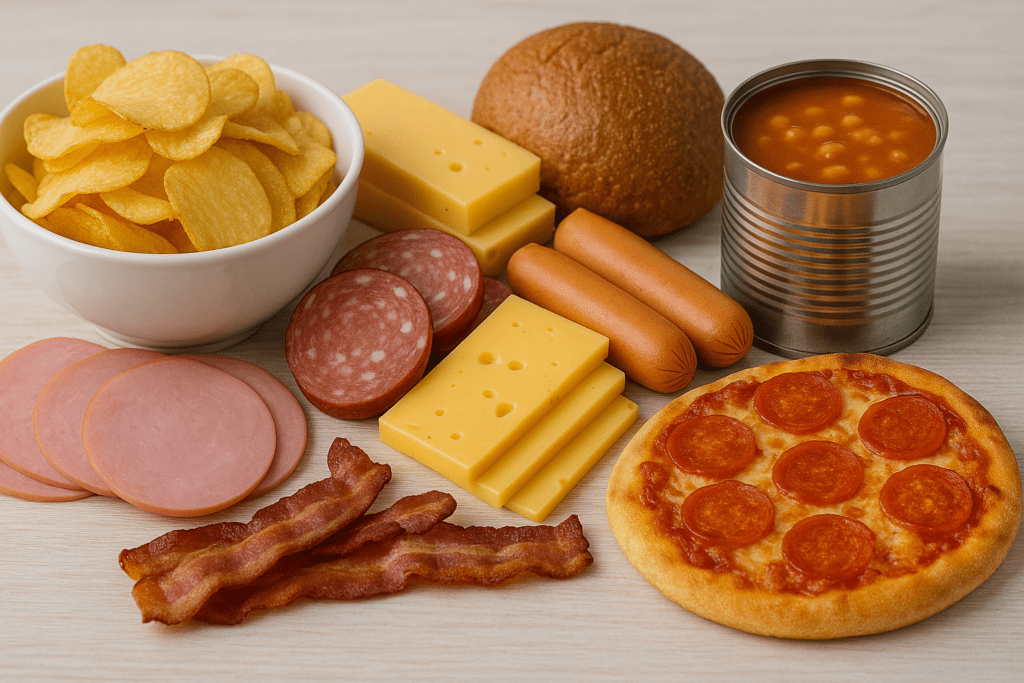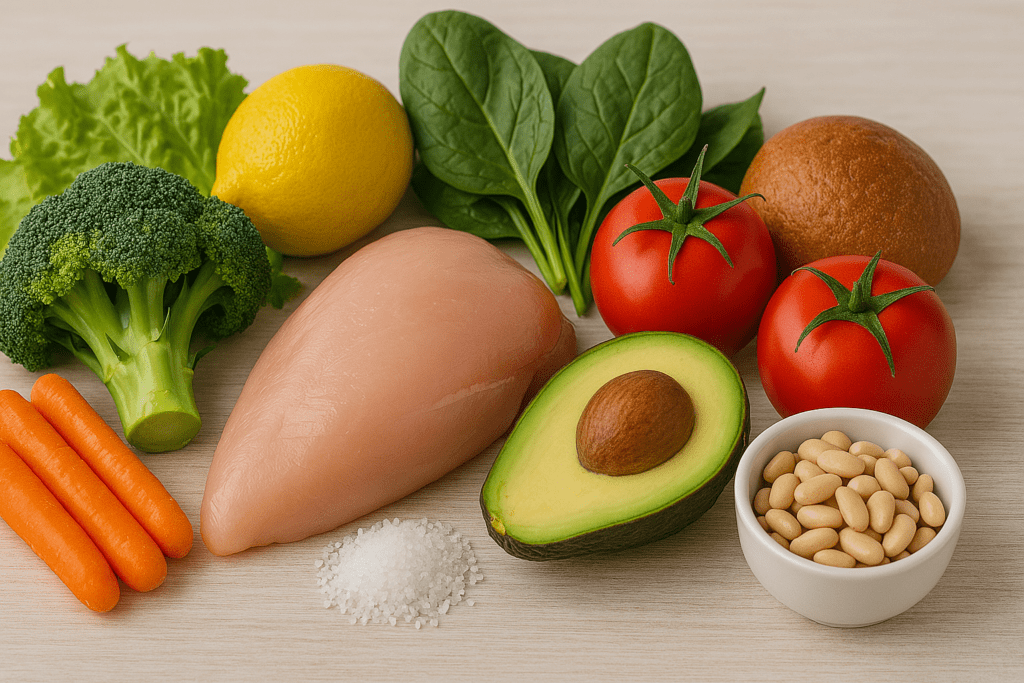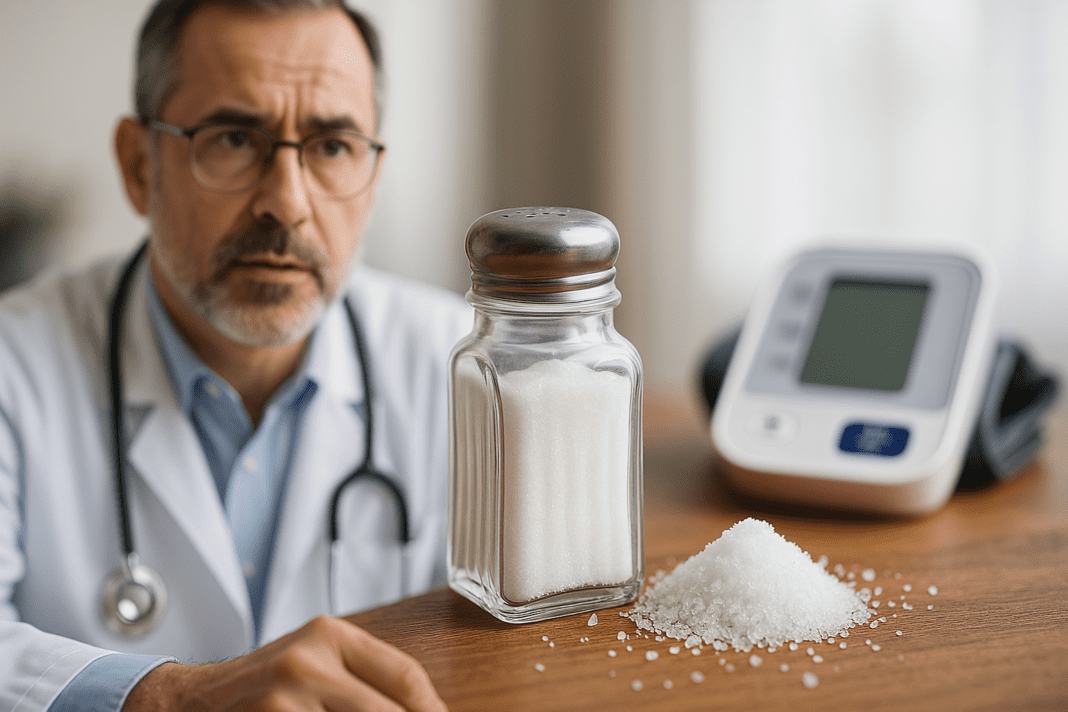High blood pressure, or hypertension, affects millions of people worldwide and remains one of the most significant risk factors for cardiovascular disease, stroke, and kidney failure. Among the various lifestyle factors that influence blood pressure, sodium intake is one of the most pivotal. Yet, despite widespread awareness of its impact, excessive salt consumption remains alarmingly common, especially in Western diets. Understanding how much sodium per day with high blood pressure is safe, what a low sodium diet entails, and how to practically implement it is essential for those managing hypertension. This article delves deep into doctor-recommended sodium limits, explores the science behind salt and blood pressure, and provides practical strategies for embracing a heart-healthy, low salt lifestyle.
You may also like: Top 15 Foods to Avoid with High Blood Pressure: What Not to Eat When Managing Hypertension
Why Sodium Matters in Hypertension
The relationship between salt and blood pressure has been extensively studied and consistently supported by decades of research. Sodium, one of the primary electrolytes in the body, plays a critical role in fluid balance, nerve function, and muscle contraction. However, when sodium levels are too high, it disrupts the delicate balance of fluid in the body, leading to increased blood volume and higher pressure against arterial walls. This physiological mechanism is one reason why a low sodium diet is so often recommended for individuals with hypertension.
One of the major concerns is that excessive sodium can stiffen blood vessels, decrease kidney efficiency, and heighten the risk of heart attacks and strokes. For those with preexisting cardiovascular disorders, the consequences of high sodium intake can be even more severe. This makes the concept of a low salt diet more than just a nutritional trend—it’s a medically endorsed therapeutic strategy.
Health authorities such as the American Heart Association, Centers for Disease Control and Prevention (CDC), and World Health Organization (WHO) consistently affirm the need for sodium reduction in populations with elevated blood pressure. Numerous clinical studies, including randomized controlled trials, have shown that reducing sodium intake leads to measurable and sustained reductions in blood pressure.
Doctor-Recommended Sodium Limits: What’s Too Much?
So, how much sodium intake per day with high blood pressure is considered safe? Most health organizations recommend that individuals with hypertension limit sodium intake to no more than 1,500 milligrams per day. To put that into perspective, one teaspoon of table salt contains roughly 2,300 milligrams of sodium, which already exceeds this guideline.
For the general population, the Dietary Guidelines for Americans suggest a daily sodium cap of 2,300 milligrams. However, for individuals with high blood pressure, heart disease, or chronic kidney disease, this recommendation is lowered to help mitigate health risks. Evidence suggests that reducing sodium intake to the 1,500-milligram range not only helps lower systolic and diastolic blood pressure but also reduces the long-term risk of cardiovascular events.
These guidelines don’t imply that sodium must be eliminated entirely. The human body needs sodium for essential functions. The problem lies in the excess, not in the nutrient itself. For people with salt-sensitive hypertension—a condition in which blood pressure responds strongly to sodium intake—even small deviations above the recommended levels can result in clinically significant spikes in blood pressure. This underscores the importance of adhering to a carefully controlled, low sodium diet.

The Science Behind Salt and Blood Pressure
To truly understand the need for a low sodium diet for high blood pressure, it’s essential to unpack the science behind how salt affects the cardiovascular system. When sodium levels rise in the bloodstream, the body retains more water to dilute the excess. This increased volume of circulating fluid raises blood pressure because the heart has to work harder to pump it through the vascular system.
Moreover, salt in hypertension has been linked to changes in arterial function. Elevated sodium levels can impair endothelial function, reduce nitric oxide availability, and promote arterial stiffness. Over time, this contributes to the development and progression of atherosclerosis, a key underlying factor in many heart-related complications.
The connection between salt and blood pressure is not uniform across all populations. Genetic factors, age, race, and the presence of other medical conditions can all influence individual salt sensitivity. For instance, older adults and African Americans are more likely to be salt-sensitive, meaning their blood pressure rises more sharply with increased sodium intake.
Additionally, research suggests that high salt consumption may blunt the effectiveness of antihypertensive medications. This makes it even more critical for those on blood pressure-lowering drugs to commit to a low salt for high blood pressure lifestyle.
What Is Considered a Low Sodium Diet?
Defining what is considered a low sodium diet can help individuals set realistic dietary goals. Generally, a low sodium diet includes no more than 1,500 to 2,000 milligrams of sodium per day. For individuals with high blood pressure or cardiovascular disease, the lower end of this spectrum is typically advised. In more extreme cases, a sodium free diet may be recommended under clinical supervision, although this is relatively rare.
Adopting a low sodium diet involves more than simply putting down the salt shaker. In fact, most dietary sodium comes not from added salt at the table but from processed, packaged, and restaurant foods. This means that even individuals who believe they are consuming little salt may still be significantly exceeding recommended limits.
Some people opt for what is known as a low NA diet, which essentially refers to reduced sodium intake by minimizing sodium chloride consumption. This often involves choosing low sodium diet foods such as fresh fruits, vegetables, whole grains, legumes, and unsalted nuts and seeds. The goal is to replace high-sodium staples with foods lower in salt and sodium while maintaining a nutritionally balanced intake.
A common question that arises is: does sodium cause high blood pressure in everyone? While not universally true, the scientific consensus affirms that lowering sodium generally lowers blood pressure across population groups, even if the magnitude of the response varies. Therefore, the benefits of a low sodium diet extend broadly and should not be dismissed even in the absence of severe hypertension.
Practical Low Sodium Diet Tips for Everyday Life
Transitioning to a low sodium diet can be challenging at first, particularly for those accustomed to heavily processed or restaurant-prepared meals. However, with the right strategies and mindset, it’s entirely possible to enjoy flavorful and satisfying meals while reducing sodium intake.
Start by reading nutrition labels carefully. Foods labeled “low sodium” must contain 140 milligrams of sodium or less per serving. Aim to stock your pantry with items that meet this criterion. Consider assembling a low sodium food list of go-to staples, such as dried beans, brown rice, fresh vegetables, and low sodium broths. This not only aids in meal planning but also minimizes the temptation to reach for high-sodium options.
Cooking at home is one of the most effective ways to control sodium levels. By preparing meals from scratch, you can avoid the hidden salts often found in sauces, condiments, and frozen entrees. Using herbs, spices, citrus, and vinegar to enhance flavor can make a no salt diet not only tolerable but genuinely enjoyable. For example, garlic, rosemary, paprika, and lemon zest can add complexity and depth to dishes without increasing sodium content.
One common misconception is that eliminating salt will automatically make food bland or unpalatable. In reality, taste preferences adapt over time. As your palate adjusts, you may begin to appreciate the natural flavors of whole foods more fully. Moreover, reducing salt doesn’t mean eliminating all sodium—just minimizing excess. There’s room for flexibility, especially when sodium is used sparingly and purposefully.
Finally, when dining out, don’t be afraid to request no added salt in your meal preparation. Many restaurants are becoming increasingly accommodating of dietary needs, including requests for foods low in salt and sodium. If dining out frequently is part of your lifestyle, look for restaurants that offer low sodium options or provide detailed nutritional information.
Foods to Avoid on a Low Salt Diet
Knowing which foods to avoid can be just as crucial as knowing which to include. High-sodium foods often lurk where people least expect them. Obvious culprits include fast food, canned soups, deli meats, pickles, salty snacks, and frozen meals. These items are often saturated with sodium either as a preservative or for flavor enhancement.
Less obvious high-sodium foods include breads and rolls, breakfast cereals, cheese, salad dressings, and even some bottled beverages. These products may not taste salty but can contain surprisingly high sodium levels per serving. This is why regularly reviewing the nutrition facts panel is vital when adopting a low sodium diet for blood pressure management.
Even so-called “health foods” can be misleading. For instance, veggie burgers, protein bars, and meat substitutes may market themselves as healthy while still containing sodium-rich additives. Individuals on a low salt diet must remain vigilant and avoid falling into the trap of healthwashing—a practice where unhealthy ingredients are obscured behind health-conscious branding.
In addition to processed foods, certain condiments like soy sauce, barbecue sauce, and ketchup can contribute significantly to daily sodium intake. Switching to low sodium versions or using alternatives like mustard, hummus, or fresh salsa can make a notable difference in achieving sodium goals.
As a general rule, whole, minimally processed foods should form the foundation of any low sodium diet food list. These include fresh fruits, leafy greens, legumes, lean proteins, and whole grains. These foods naturally support cardiovascular health and offer the added benefit of being low in sodium while rich in essential nutrients.

Does Salt Really Raise Blood Pressure? Unpacking the Evidence
The question “does salt raise blood pressure?” is one that continues to generate discussion. While individual responses vary, the broader scientific consensus affirms a clear association. Numerous large-scale studies, including the DASH-Sodium trial and the INTERSALT study, have shown that high sodium intake correlates with elevated blood pressure, especially in older adults and those with existing cardiovascular issues.
Importantly, these studies also demonstrate that reductions in sodium intake can lead to meaningful decreases in both systolic and diastolic blood pressure. These benefits are even more pronounced when sodium reduction is paired with other lifestyle interventions such as increased potassium intake, weight management, regular physical activity, and limited alcohol consumption.
Still, skeptics occasionally argue that salt’s impact is overstated. They cite studies with conflicting outcomes or point to individuals who consume high amounts of salt without developing hypertension. While such cases exist, they represent exceptions rather than the rule. From a public health standpoint, the evidence overwhelmingly supports reducing sodium as a means of lowering blood pressure and reducing disease burden.
The concept of salt sensitivity explains why sodium affects individuals differently. Those with salt-sensitive hypertension may experience sharp increases in blood pressure with modest increases in sodium, whereas salt-resistant individuals may exhibit less variation. However, this variability does not negate the general trend that excess sodium raises cardiovascular risk.
Thus, while the question of “does sodium increase blood pressure” may have a nuanced answer, the takeaway is simple: reducing sodium is a safe, effective, and widely recommended strategy for managing high blood pressure and preventing cardiovascular complications.
Can You Eat Too Little Salt? Risks of Extreme Sodium Restriction
Although the benefits of sodium reduction are well-documented, some individuals worry about going too far. A common concern is whether following a no salt diet or extremely low sodium intake might lead to unintended health consequences, such as low blood pressure or electrolyte imbalances.
In healthy individuals, sodium deficiency is rare. However, excessive sodium restriction in vulnerable populations—such as those with certain adrenal disorders, chronic kidney disease, or eating disorders—can lead to hyponatremia, a condition characterized by dangerously low blood sodium levels. Symptoms may include fatigue, confusion, nausea, and muscle cramps.
That said, the average person consuming a typical Western diet is far more likely to suffer from excess sodium than deficiency. The phrase “can not eating no salt cause blood pressure” issues may reflect a misunderstanding of sodium’s role. While sodium is essential, extremely low intake is unlikely to cause high blood pressure. If anything, insufficient sodium typically leads to reduced blood pressure or related symptoms of hypotension.
For individuals concerned about how to lower blood sodium safely, the goal should be gradual, sustainable changes rather than abrupt, extreme shifts. Focus on eating more foods lower in sodium, reducing processed food consumption, and balancing sodium with potassium-rich choices like bananas, sweet potatoes, and spinach.
Frequently Asked Questions: Sodium Intake, Blood Pressure, and Low Salt Diet Strategies
1. Can switching to a low sodium diet affect energy levels or mental clarity?
Yes, transitioning to a low sodium diet can temporarily affect energy levels or mental clarity, especially in individuals accustomed to high-salt eating habits. Sodium plays a role in fluid balance and nerve conduction, so a sudden reduction may lead to mild fatigue, lightheadedness, or decreased focus as the body adjusts. However, these effects are usually short-lived and often subside once the body reaches a new sodium equilibrium. For individuals following a low salt diet, staying well-hydrated and ensuring adequate intake of other electrolytes like potassium and magnesium can help minimize these effects. Over time, most people report feeling more energized on a low sodium diet, especially when it is based on nutrient-dense low sodium diet foods rather than ultra-processed alternatives.
2. What are some advanced strategies to maintain a low sodium diet when traveling or dining out frequently?
Traveling or eating out regularly can make it harder to follow a low sodium diet, but advanced planning helps tremendously. Choose restaurants that offer customizable meals or provide nutritional information, allowing you to select foods low in salt and sodium. Carrying a small bottle of salt-free seasoning or requesting sauces and dressings on the side can help reduce your sodium intake without compromising flavor. For frequent flyers or road travelers, packing a low sodium diet food list with shelf-stable options like unsalted trail mix, dried fruit, or low sodium crackers can ensure better choices are available. Ultimately, staying informed and proactive enables adherence to a low salt for high blood pressure lifestyle even in less controlled environments.
3. Are there any psychological or behavioral challenges associated with reducing sodium, and how can they be overcome?
Yes, sodium reduction can present behavioral challenges, especially due to taste dependence and emotional eating habits tied to salty foods. Many individuals experience cravings during the first few weeks of a low salt diet, which can make adherence difficult. These cravings are driven not just by habit, but by the body’s conditioned taste response. A helpful strategy is to gradually reduce sodium rather than eliminating it abruptly, allowing the palate to adjust naturally. Incorporating flavorful herbs, umami-rich ingredients like mushrooms, and citrus can help bridge the gap while fostering sustainable commitment to low sodium diet blood pressure goals.
4. How does the long-term impact of salt intake compare to other dietary risk factors for hypertension?
Long-term salt intake is a significant and modifiable risk factor for hypertension, often on par with excess alcohol consumption, physical inactivity, and poor weight management. While some dietary risks like high saturated fat or sugar intake are better known, salt and blood pressure share one of the most direct and biologically supported links. Not only does chronic high sodium intake increase blood pressure, but it also exacerbates the vascular damage caused by other risk factors. For this reason, adopting a low sodium diet is a cornerstone intervention, especially when combined with foods lower sodium and rich in potassium, fiber, and antioxidants. This multifaceted dietary approach offers broader cardiovascular protection than sodium reduction alone.
5. Does salt raise blood pressure differently depending on the type of salt used (e.g., sea salt, Himalayan salt, or table salt)?
Despite marketing claims, all types of salt—including sea salt, Himalayan pink salt, kosher salt, and traditional table salt—contain roughly the same amount of sodium by weight. The idea that certain salts are “healthier” is often a misconception. While unrefined salts may contain trace minerals, the quantities are nutritionally insignificant and do not mitigate the core issue: sodium intake. Therefore, switching salt types does not meaningfully change the answer to “does salt raise blood pressure?” Regardless of the form, excess sodium remains the primary concern, and adhering to a low NA diet is more impactful than choosing between types of salt.
6. What is the role of hidden sodium in medications and supplements, and should it be a concern?
Yes, hidden sodium in medications, especially effervescent tablets and over-the-counter antacids, can significantly contribute to daily sodium intake. Individuals carefully managing how much sodium per day with high blood pressure they consume should read product labels or consult healthcare providers about the sodium content of their prescriptions. Some medications use sodium bicarbonate or sodium benzoate as stabilizers, which may not be obvious unless specifically listed. When managing salt in hypertension through diet, overlooking medicinal sources of sodium could undermine progress. Opting for sodium-free formulations or asking for alternatives can help support a comprehensive low sodium diet strategy.
7. Is there a risk of under-consuming sodium for individuals on strict low sodium or no salt diets?
While most individuals benefit from reducing sodium, extremely strict regimens—such as a sodium free diet or overly restrictive no salt diet—can lead to unintended consequences in certain cases. Hyponatremia, or low blood sodium, may occur if sodium loss through sweat, diarrhea, or diuretics is not adequately replaced. The risk is higher in endurance athletes, the elderly, or those with specific medical conditions. That said, the majority of people consume far more sodium than needed, and even a low sodium diet food list typically provides enough to prevent deficiency. The goal is not total elimination, but a balanced approach that respects the body’s physiological need while reducing cardiovascular strain.
8. How does potassium interact with sodium in blood pressure regulation, and why is it important on a low salt diet?
Potassium plays a vital counter-regulatory role in blood pressure management by promoting vasodilation and helping the kidneys excrete excess sodium. This dynamic balance is why a diet high in potassium-rich foods, such as leafy greens, bananas, lentils, and sweet potatoes, enhances the effects of a low salt diet. Focusing solely on reducing sodium without increasing potassium intake may limit the potential benefits. Additionally, foods lower sodium and higher in potassium often include whole, unprocessed items that support overall cardiovascular health. Incorporating a variety of potassium-rich options into your low sodium diet food list can maximize the effectiveness of dietary intervention for hypertension.
9. Are there population groups who benefit more from a low sodium diet than others?
Yes, certain populations are more salt-sensitive and derive greater benefit from sodium restriction. Older adults, African Americans, individuals with chronic kidney disease, and those with insulin resistance often experience more pronounced blood pressure reductions from low sodium diets. For these groups, even modest sodium reduction can significantly improve clinical outcomes. Understanding how much sodium intake per day with high blood pressure is tolerable may differ slightly by individual, but these high-risk populations often require stricter targets. Tailoring a low sodium diet to meet personal needs—while maintaining nutritional adequacy—is essential in these cases.
10. What emerging research is exploring the future of sodium-related hypertension treatment?
Emerging research is examining how personalized nutrition and microbiome science can influence salt and blood pressure regulation. Scientists are exploring how gut bacteria interact with dietary sodium to affect inflammation and vascular tone. Additionally, wearable health tech is being tested to monitor real-time sodium excretion and hydration status, which could help tailor sodium targets more accurately. There is also interest in developing functional foods or natural sodium channel blockers that support a low salt diet while improving adherence. As this field evolves, future interventions may go beyond the traditional low sodium food list to include precision-guided strategies that integrate genetic, metabolic, and lifestyle data.

Final Thoughts: How to Reduce Sodium Levels and Protect Your Heart
Learning how to reduce sodium levels is a powerful step toward better heart health, especially for those with or at risk of hypertension. The process starts with awareness—understanding how much sodium per day with high blood pressure is safe, identifying hidden sources of salt, and recognizing how sodium affects your unique physiology.
Embracing a low sodium diet for blood pressure control is not about deprivation; it’s about informed, intentional choices. Whether you’re stocking up on low sodium diet foods, choosing foods low in salt and sodium, or simply learning how salt affects blood pressure, every small step contributes to a larger impact. Even modest reductions in daily sodium intake can translate to significant improvements in cardiovascular outcomes over time.
As with any dietary change, consistency is key. A low salt diet doesn’t require perfection—just progress. By cultivating a habit of mindful eating, preparing meals at home, avoiding overly processed items, and remaining vigilant about nutritional labels, you can achieve a healthier sodium balance.
Ultimately, whether you’re managing an existing diagnosis or trying to prevent one, understanding salt and blood pressure gives you the knowledge and tools to take control of your health. Let the science guide your decisions, and remember: when it comes to sodium and heart health, less is often more.
hypertension diet plan, sodium and heart health, cardiovascular nutrition tips, managing high blood pressure naturally, heart-healthy lifestyle choices, reducing processed food intake, salt sensitivity in adults, DASH eating plan, hidden sodium in foods, kidney function and sodium, electrolyte balance and blood pressure, healthy cooking without salt, restaurant dining with hypertension, salt alternatives for flavor, fluid retention and salt, nutrient-dense low sodium meals, anti-inflammatory diet for heart health, understanding sodium labels, preventing hypertension complications, sodium awareness campaign
Further Reading:
Your guide to low sodium eating and how to lower blood pressure
Sodium Intake and Hypertension
Low-Sodium Diet: Benefits, Food Lists, Risks and More
Disclaimer
The information contained in this article is provided for general informational purposes only and is not intended to serve as medical, legal, or professional advice. While MedNewsPedia strives to present accurate, up-to-date, and reliable content, no warranty or guarantee, expressed or implied, is made regarding the completeness, accuracy, or adequacy of the information provided. Readers are strongly advised to seek the guidance of a qualified healthcare provider or other relevant professionals before acting on any information contained in this article. MedNewsPedia, its authors, editors, and contributors expressly disclaim any liability for any damages, losses, or consequences arising directly or indirectly from the use, interpretation, or reliance on any information presented herein. The views and opinions expressed in this article are those of the author(s) and do not necessarily reflect the official policies or positions of MedNewsPedia.


